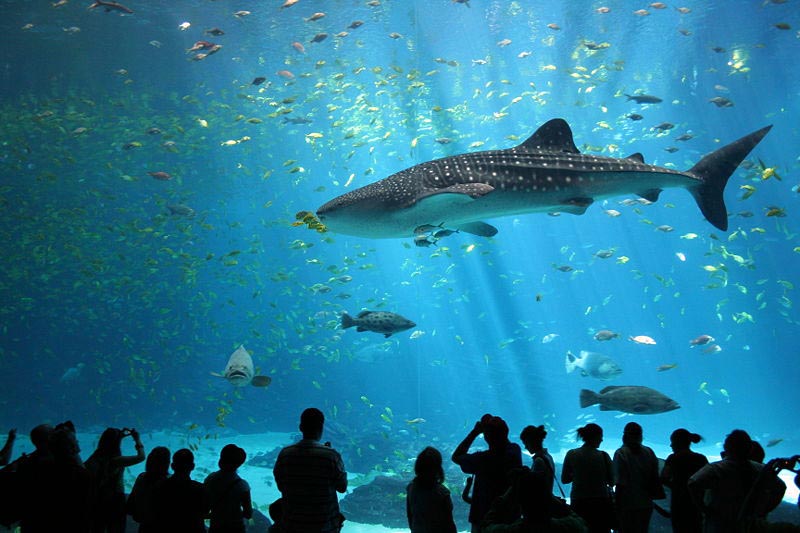
Travel India Whale Sharks
“Whale Sharks are the largest fish in the sea, and yet, we know the least about them,” Jeff Swanagan, Executive Director and President, declared shortly after the opening of the Georgia Aquarium in Atlanta, U.S.
Seeing a Whale Shark in the ocean is very rare.
Even well-known oceanographers such as Dr. Sylvia Earle and Philippe Cousteau did not see their first Whale Shark until coming to an aquarium.
Whale Sharks frequently enter the coastal waters around India.
A few are washed ashore.
Nature lovers try to push them back to deeper waters.
Fortunately for us, today, most of the larger public aquariums display Whale Sharks.
Description
Believed to have originated about 60 million years ago, the Whale Shark, Rhincodon typus, is the largest living fish in the world.
The Whale Shark was first identified in April 1828 following the harpooning of a 4.6 metres (15.1 feet) specimen in Table Bay, South Africa.
It was described the next year by Andrew Smith, a military doctor with the British troops in Cape Town.
He published a more detailed description of the Whale Shark in 1849.
It is actually a shark, as large as a whale, and filter feeds in the same way as whales do.

The largest accurately recorded specimen was caught on November 11, 1947, near the island of Baba, near Karachi, Pakistan.
It was 12.65 metres (41.50 feet) long, weighed more than 21.5 tons (47,300 lb), and had a girth of 7 metres (23.0 feet).
Distribution and habitat
The Whale Shark is found in open waters in tropical and warm-temperate oceans around the world.
Its range is restricted to about ± 30 ° latitude.
It is found to a depth of 700 metres (2,300 ft).
It is usually solitary.
Males range over longer distances than females.
Seasonal feeding congregations of the Whale Sharks occur at several coastal sites such as Ningaloo Reef (Western Australia); Útila (Honduras); Donsol and Batangas (Philippines); off Isla Mujeres and Isla Holbox (Yucatan Mexico); and the Tanzanian islands (Pemba and Zanzibar).
Description and Feeding
The Whale Shark is a filter feeder.
It has a huge mouth which can open up to 1.5 metres (4.9 feet) wide and contains between 300 and 350 rows of tiny teeth.
It has five large pairs of gills.
The two small eyes are located towards the front of the shark’s wide, flat head.
The body is mostly grey with a white belly.
Three prominent ridges run along each side of the Whale Shark and the skin is marked with a “checkerboard” of pale yellow spots and stripes.
These spots are unique to each whale shark and are used to identify each animal.
The skin can be up to 10 centimetres (3.9 inches) thick.
The Whale Shark is not an efficient swimmer and uses its entire body for swimming, reducing its speed to an average of around 5 kilometres per hour (3.1 mph).
Diet
The Whale Shark is a filter feeder — one of only three known filter feeding shark species (the other two are the basking shark and the megamouth shark).
It feeds on phytoplankton, macro-algae, plankton, krill, small fish and small nektonic life, such as small squid or vertebrates.
The rows of tiny teeth play no role in feeding.
The shark sucks in a mouthful of water, closes its mouth and expels the water through its gills. The plankton and other food material is trapped inside and swallowed.
The Whale Shark and Divers
The Whale Sharks are quite gentle and allow divers to play with them.
Divers and snorkellers can swim with them and even touch them without any risk apart from unintentionally being struck by the shark’s large tail fin.
The shark is often seen by divers in The Bay Islands in Honduras, Thailand, the Philippines, the Maldives, the Red Sea, Western Australia (Ningaloo Reef and Christmas Island), Gladden Spit Marine Reserve in Belize, Tofo Beach in Mozambique, Sodwana Bay (Greater St. Lucia Wetland Park) in South Africa and at the Galapagos Islands.
The highest concentration of Whale Sharks to be found anywhere in the world is in the Philippines. From January to May, they congregate in the shallow coastal waters of Sorsogon province (at Donsol).
Recently 150 Whale Sharks have been tagged and identified off the coast off Hol Box Island, Mexico. The island is located north of Cancun in the Gulf of Mexico. They visit the island from June through August and more have been identified every year.
Tour guides can organise swimming with these enormous creatures.
The reproductive habits of the Whale Sharks are obscure.
It was earlier believed to be oviparous, but the capture of a female in July 1996 which was pregnant with 300 pups proved that they are ovoviviparous.
The eggs remain in the body and the females give birth to live young which are 40 centimetres (15.7 in) to 60 centimetres (23.6 in) long.
It is believed that they reach sexual maturity at around 30 years and live to over 100 years.
The Whale Sharks are captured by artisanal and commercial fisheries in several areas where they seasonally aggregate.
However, they are not endangered.
IUCN has classified them as vulnerable.
Fishing, selling, importing and exporting of Whale Sharks for commercial purposes has been banned in the Philippines in 1998; in India in May 2001; and by Taiwan in May 2007.
Whale Sharks in India
Around 1,200 Whale Sharks migrate from East Africa to the Gujarat coast in the Indian Ocean for breeding every year.
About one thousand were slaughtered by Gujarat’s fishermen between 1990- 2001, who killed them for their oil, fins and meat. These fetched high prices in the international market.
This has been possible through ‘Save the Whale Shark’ – a joint awareness campaign, conducted by the Wildlife Trust of India (WTI), the International Fund for Animal Welfare, Tata Chemicals and the Gujarat government since 2004.
Watching the magnificent creatures is a unique experience.
India is doing a wonderful job protecting and saving them.

